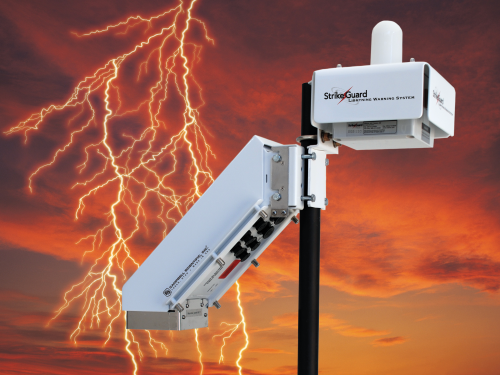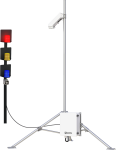
Overview
The SG000 is an optical-coincidence lightning sensor that detects actual lightning strikes for up to 20 miles away. Available as an option for our CS110 Electric Field Meter, the SG000 Strike Guard is used in conjunction with the CS110 to create a complete lightning-threat measurement and analysis system. Data from the two sensors can be used to control warning systems and to help personnel make evacuation and shutdown decisions.
Read MoreBenefits and Features
- Fully integrates into CS110 system
- 20-mile detection radius
- Avoids false alarms with patented technology
- 定期自测传感器和通信
- Durable fiber-optic communication with connector-less technology
- Lightning-proof data communication
Images

Similar Products
Detailed Description
The SG000 Strike Guard detects cloud and cloud-to-ground lightning within a 20-mile radius. Strike information is classified in three range categories as lightning detected within 5 miles, 10 miles, and 20 miles. To prevent false alarms, the SG000 requires an optical signal to coincide with a magnetic-field-change signal before reporting lightning.
The SG000 is typically mounted on the same tripod or pole as the CS110. The SG000 connects to the CS110 via the FC100, the 14291 Field Power Cable, and the FC100CBL1-L (typically 10+ feet), and the following equipment depending on which CS110 port it is connected to.
Lightning Detection Ranges
The SG000 has three categories for lightning detection range estimates:
- CAUTION: Lighting is within 20 miles.
- WARNING: Lightning is within 10 miles.
- ALARM: Lighting is within 5 miles.
CS I/O Port
- CS110CBL2-L (typically 9 feet)
- SC932A
- 16987 Peripheral Mtg kit
RS-232 Port
- CS110CBL1-L (typically 9 feet)
The SG000 is an add-on option to the CS110. Due to a contractual agreement, it cannot be sold without the CS110, as a stand-alone sensor.
Specifications
| Detection Range | Up to 32.19 km (20 mi) radius |
| Enclosure Rating | NEMA 4X |
| Internal Battery | Lithium primary cells with four-year life minimum |
| Dimensions | 20.3 x 17.8 x 19.1 cm (8 x 7 x 7.5 in.) |
| Weight | 1.6 kg (3.5 lb) |
Compatibility
The SG000 is used with our CS110 Electric Field Meter.
Frequently Asked Questions
Number of FAQs related toSG000:4
Expand AllCollapse All
-
According to the manufacturer, "Lightning flashes in the Alarm category are most likely to have occurred within 5 miles of the Sensor. Lightning flashes in the Warning category are most likely to have occurred within 10 miles of the Sensor. Lightning flashes in the Caution category are most likely to have occurred within 20 miles of the Sensor."
The SG000 is not capable of determining the exact distance to a lightning strike. Determining the exact distance would require multiple sensors and a triangulation method using TOA (Time of Arrival).
-
The CS110 and the tower should be positioned away from each other a distance of three times the tower’s height.
If the radio signal is strong enough, the SG000 may pick it up as one of the two components the SG000 measures to detect lightning. If this signal coincides with a light flash from a windshield or headlight, it could generate a false strike signal. Also, constant bombardment of the SG000 by sufficiently strong RF signals will pull the sensor out of its quiescent state, affecting its current drain. This will eventually degrade the battery and shorten its expected four-year lifespan.
-
To simulate a lightning strike to the SG000, use a camera flash to flash the glass bulb from a distance of 5.08 to 7.62 cm (2 to 3 in.). Note: A flash from a cell phone usually isn't large enough to simulate a lightning strike.
To simulate high electric fields on the CS110, run a comb through your hair and hold it a distance of 2.54 to 5.98 cm (1 to 2 in.) from the shutter of the CS110. Other items such as plastic bags or balloons, or fur on glass, can be used as well.
-
The FC100 is required to communicate with the SG000 Strike Guard Lightning Sensor. The SG000 is an option for the CS110 Electric Field Sensor and the LW110 Lightning Warning System.
Articles and Press Releases
Privacy Policy Update
We've updated our privacy policy.Learn More

